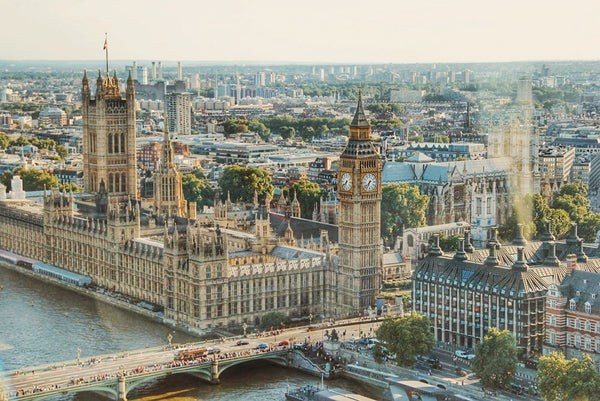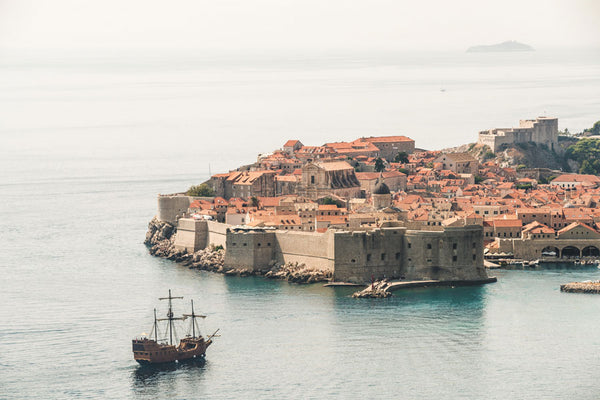Fall in Europe - Packing List (Guide)
Sep 22, 2020
Europe is big and diverse — it is different to visit Greece during summer or Sweden during winter. This list is aimed at travelers coming to Europe during fall, from mid-September to mid-November, to central and southern European countries. You can follow the guide even if you are visiting northern countries, but keep in mind that you will need to pack more warm clothes. To avoid any surprises, always remember to check the weather conditions as your trip is getting closer.
Besides the right clothes, your Europe packing list for fall should include gadgets that will make your life (erm, trip) easier. And, of course, the right documents. Take a look!
Must-have Things When Traveling to Europe
For most of the developed countries, traveling across Europe has never been easier. A lot of popular European countries abolished borders between each other, so you can, for example, travel from Portugal to France to the Netherlands without having to show your documents. Of course, there are regulations regarding entering Europe, so read the list to make sure you have all the right papers with you.
Passport
When entering any European country from an international destination, you will need a valid passport as proof of your identity. Most European countries require your passport to be valid for at least three months beyond your planned date of departure, so pay attention to the expiration date when planning your trip. Also, keep in mind that driving licenses are not accepted as valid travel documents.

London, picture by Dominika Gregušová, Pexels
Visa
The first thing you need to know is that Europe is divided into two areas — the Schengen Area and the non-Schengen area. The Schengen Area includes 26 European countries, most of them members of the European Union and a few not, that have abolished passports and other types of controls at their mutual borders. Here you can see the full list of the Schengen countries.
Citizens of the U.S., Canada, New Zealand and Australia can enter Schengen without a visa for short-term trips (maximum of 90 days in a period of 180 days). Citizens from some other non-EU countries are required to hold a visa when traveling to the area. Click here for more info on those countries.
Rules for visiting the non-Schengen area can vary from country to country, so it is best to look up the pages of their foreign ministries to get full details. The list of European countries that are not members of the Schengen zone is available here.
Travel insurance
Wherever you go, it is always a good idea to have travel insurance in case an accident of any kind happens. Make sure to choose the right travel and medical insurance for you, so that there are no unpleasant surprises when you try to make a claim. There are various types of insurance policies tailored for different budgets and trips, and they start from as little as €0.99/$0.99 per day.
Money
Euro is the official currency of:
- 19 out of 27 member states of the European Union (known as the eurozone)
- the four microstates (Andorra, Monaco, San Marino and Vatican City)
- Montenegro and Kosovo.
The rest of the European countries have different currencies — you can see the full list of European currencies here.
You can exchange money pretty much at every corner of European capitals and bigger cities, as there are lots of exchange offices and ATMs. Make sure to take enough cash with you if you are going somewhere remote (we are talking small villages, not holiday resorts), as there you may not find an exchange office or a possibility to pay with a card.
International driving permit
Europe is great for road-tripping because you can see more than a few countries in a short period of time. If you are planning on renting a car, check rental requirements for every country you wish to visit because some countries ask for an International Driving Permit — you can apply for it online. The cost depends on how long the permit will last (from 1 to 3 years) and where you live.

Rome, picture by Julius Silver, Pexels
Packing List for Fall in Europe
Of course, a glamorous trip to Italy calls for different outfits than hiking in France, but our list can serve as a guide for the essentials. Check out what we recommend to put on a packing list for traveling to Europe in the fall.
T-shirts
An ideal packing list for a fall trip to Europe includes a couple of cozy T-shirts. Fall temperatures in Europe can vary from 8 to 23 °C (46 to 74 °F), with colder mornings and warm afternoons, and a comfy tee is a great base for a layered outfit. A nice polo shirt will do if you are planning on going somewhere nicer. Bring a couple of options so that you can mix and match with different colored bottoms.
Shirts
A long-sleeved shirt is also a great starting point for building an outfit. Bring classic pieces like black and white turtlenecks, combine them with trousers and blazers, and voilà, you have the perfect outfit for a day of sightseeing! Keep in mind that in Europe anything goes — you can express your style with anything from a fancy blouse to a punk checkered shirt.
Sweaters
Is there anything nicer than wearing a cozy oversized sweater? We believe not, so you can definitely make room in your suitcase for one or two of your favorite fall pieces.
Jeans
The best packing list for Europe in fall definitely includes a couple of jeans. From skinny and boyfriend jeans to ripped, wide-legged and high-waisted ones, Europeans like them all. Choose a style you usually like to wear — you will fit right in and look like a local.
Skirts
If you prefer wearing skirts, pack the ones that you can mix with various tops. Choosing between maxi, midi or mini skirts depends entirely on your style, just bear in mind not to go too short if you are planning on visiting churches or sanctuaries. Today there is a big offer of skirts with hidden pockets, perfect for holding small items like keys, cards or money.
Dresses
Think about dresses that can go from day to night and can be dressed up or down. Faux wrap dresses, button-downs, shirt and jersey dresses are all great options.
Jackets
Fall in Europe can be quite rainy, so definitely pack a rain jacket. It can be thrown into the bottom of your bag and it won't take much space. If you want to make sure to always stay warm, bring a fleece jacket — it will provide a lot of warmth without adding bulk.
Accessories
Every fashionista knows that adding the right accessory can make the outfit, so pack hats, scarves and belts that will go well with the wardrobe you are taking. Shopping in Europe is great, so you can buy some new pieces during your trip.
Shoes
If you are planning to visit a bigger European city, bring comfortable walking shoes, as you will probably spend the majority of your days walking. If you have enough room, pack more than one pair in case you get blisters. If you are planning on spending time in nature, bring a pair of comfy boots that can withstand rain and mud.

Barcelona, picture by Aleksandar Pasaric, Pexels
Tips for Choosing Clothing for Travel
Follow these tips to avoid any clothing-related problems.
- Choose versatile clothes that look good with other items you are bringing.
- Pack low maintenance items that do not have special washing instructions.
- Pick wrinkle-resistant fabrics that will look great despite being in a suitcase for longer periods of time.
Travel Gear List for Fall in Europe
Choosing different wardrobe options for a European trip can be fun, but who wants to think about gadgets, adapters and cables? Do not worry, just go through our gear packing list for Europe in fall and you will be fine.
Travel adapter
If you are coming to Europe from another continent, you will definitely need adapters for your electronics. You can choose from a large variety of adapters, from budget-friendly options to modern devices suitable for all European countries. Make sure to check requirements for the countries you are planning to visit because not all European countries have the same plugs.
Power bank
Although you are not supposed to spend time on your phone during a vacation, we all need those little devices more than we might admit. We depend on them for everything from checking the museum working hours, to finding the closest restaurant and calling a taxi. Make sure to not run out of your battery during sightseeing and keep a power bank in your day bag. Check out some great options.
Camera
Many travelers include a camera on their packing list for Europe in fall. Whether you are planning on walking the streets of Paris, taking a gondola ride in Venice or exploring Spanish villages, you will see moments worth capturing. If you are already into photography, invest in something more professional, but there are a lot of options for aspiring photographers as well.
Day bag
As you will spend most of the time outdoors, think about taking a day bag which can hold all the stuff you wish to carry around every day, plus some extra space for souvenirs. A good day bag should:
- be safe (take a look at some great anti-theft backpacks)
- match your style, of course!
Umbrella
We have already mentioned — Europe during fall can get rainy. Do not be discouraged from a day of activities because of bad weather, take an umbrella with you. Thankfully, many manufacturers recognized that carrying an umbrella can be inconvenient, so there is a great offer of compact umbrellas for travelers.
Water bottle
Staying hydrated is important each day, but especially during your travels when you are more likely to get sweaty and exhausted. Make sure to never run out of drinking water and make room for a water bottle in your day bag. Think green and choose a reusable water bottle from high-quality material.
Sunscreen
No matter which time of the year you are going on your trip, it is highly recommended to protect your skin from the sun. Develop a habit of applying sunblock every day and put some type of sunscreen on the top of your packing list for Europe in fall.

Dubrovnik, picture by veeterzy, Pexels
Student ID
If you are a student, you are probably looking for ways of staying on a budget. Make sure to carry your student ID with you, because many European museums and attractions have special discounts for students. In most European countries, you can also buy cheaper bus and train tickets.
Earplugs
Taking a pair of earplugs is a good idea even if you do not consider yourself a light sleeper. Europe can get loud, especially if you are staying in a hostel or in the city center where you can hear people from the streets. Not to mention wanting to sleep during flights or bus rides.
Hand sanitizer
Using a hand sanitizer was smart even before the 2020 pandemic. Do not rely on restaurants or shops having sanitizers at the entrance, take one with you to make sure you can disinfect your hands in any situation. It won't take too much space in your bag, so that is one more plus side of carrying it with you.
How to Pack More Lightly
Packing lightly is not easy, but, if you manage to do it, you will be thankful for it once you find yourself in a packed metro or have to carry your suitcase through four flights of stairs. Luckily, packing light does not mean you have to leave all of your favorite things at home. Follow these tips to learn how to keep your luggage to a minimum and still manage to pack everything you want.
- Use packing cubes and organizers: organize your bag like a pro with packing cubes. They will keep your clothes compressed and folded flat and you will get to use every inch of your suitcase.
- Plan your outfits: we all have the problem of taking too many clothes. Try to think about your activities (day spent in nature, dinner in a restaurant, visiting a museum), plan what you are going to wear for each and take a couple of extra pieces just in case.
- Bring a quick-drying travel towel: regular cotton towels are bulky and some hostels do not provide towels, so it is best to pack a quick-drying towel, which is lightweight, absorbent and dries quickly.
- Pack travel-sized toiletries: you do not need to have a whole bottle of shampoo and conditioner with you, so try to replace bulky sizes with mini versions designed especially for travelers.
Our list contains everything you need to put on a packing list for 2 weeks in Europe during fall, from your favorite shirts to power banks, but it can also serve for shorter or longer trips. Check these items off your packing list and — bon voyage!

